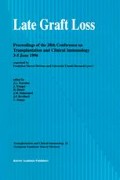Abstract
Hyperlipidemia is an important complication of solid-organ transplantation, affecting up to 80% of heart [1] and 75% of kidney [2] transplant recipients. The potential causes of hyperlipidemia in transplant recipients include dietary indiscretion secondary to prednisone therapy and an improved sense of well-being in the posttransplant period, genetic predisposition and side-effects of both prednisone and cyclosporin. The possible consequences of posttransplant hyperlipidemia include an increased risk for both cardiovascular morbidity and mortality and the development of chronic rejection. Kidney transplant recipients are at high risk for the development of ischemic heart disease, peripheral vascular disease and cerebrovascular disease [3]. It has been reported that 55% of deaths in renal transplant recipients with functioning grafts were cardiovascular in nature [4], In addition to the cardiovascular risk of posttransplant hyperlipidemia, there is growing evidence suggesting a correlation between high lipid levels and the development of chronic rejection (or allograft vasculopathy) after kidney [5–7] and heart [8] transplantation.
Access this chapter
Tax calculation will be finalised at checkout
Purchases are for personal use only
Preview
Unable to display preview. Download preview PDF.
References
Ballantyne CM, Radovancevic B, Farmer JA. Hyperlipidemia after heart transplantation: report of a 6-year experience, with treatment recommendations. J. Am. Coll. Cardiol. 1992; 19: 1315–1321.
Ong CS, Pollock CA, Caterson RJ, Mahony JF, Waugh DA, Ibels LS. Hyperlipidemia in renal transplant recipients: natural history and response to treatment. Medicine 1994; 73: 215–223.
Kasiske BL, Guijarro C, Massy ZA, Wiederkehr MR, Ma JZ. Cardiovascular disease after renal transplantation. J. Am. Soc. Nephrol. 1995; 7: 158–165.
United States Renal Data System. USRDS 1994; Annual Data Report. Bethesda, MD: The National Institutes of Health: National Institutes of Diabetes and Digestive and Kidney Diseases; 1994.
Dimeny E, Fellström B, Larsson E, Tufveson G, Lithell H. Hyperlipoproteinemia in renal transplant recipients: is there a linkage with chronic vascular rejection? Transplant. Proc. 1993; 25: 2065–2066.
Dimeny E, Fellström B, Larsson E, Tufveson G, Lithell H. Chronic vascular rejection and hyperlipoproteinemia in renal transplant patients. Clin. Transplant. 1993; 7: 482–490.
Isoniemi H, Nurminen M, Tikkanen MJ et al. Risk factors predicting chronic rejection of renal allografts. Transplantation 1994; 57: 68–72.
Johnson MR. Transplant coronary disease: nonimmunologic risk factors. J. Heart Lung Transplant. 1992; 11: S124–S132.
Kobashigawa JA, Murphy FL, Stevenson LW et al. Low-dose lovastatin safely lowers cholesterol after cardiac transplantation. Circulation 1990; 82 (Suppl 4): S281–S283.
Vanhaecke J, Van Cleemput J, Van Lierde J, Daenen W, De Geest H. Safety and efficacy of low dose simvastatin in cardiac transplant recipients treated with cyclosporine. Transplantation 1994; 58: 42–45.
Kobashigawa JA, Katznelson S, Laks H et al. Impact of pravastatin on outcomes after cardiac transplantation. N. Engl. J. Med. 1995; 333: 621–627.
Katznelson S, Wilkinson AH, Kobashigawa JA et al. The effect of pravastatin on acute rejection after kidney transplantation — a pilot study. Transplantation 1996; 61: 1469–1474.
Cooksey G, Robbins RA, Blarney RW. Natural killer cells in renal allograft rejection. Br. J. Surg. 1984; 71: 874–877.
Lefkowitz M, Jorkasky D, Korwbluth J. Increase in natural killer activity in cyclosporin-treated renal allograft recipients during rejection. Hum. Immunol. 1987; 19: 139–149.
Lewis CE, McGee JU. The natural killer cell. New York: Oxford University Press, 1992: 175–203.
Wenke K, Thiery J, Meiser BM, Arndtzn N, Seidel D, Reichart B. Reduction of graft vessel disease after heart transplantation by maximal treatment of hypercholesterolemia after heart transplantation. Am. Soc. Transplant. Phys. (Abstract book) 1994: 83.
Goldstein JL, Brown MS. Regulation of the mevalonate pathway. Nature 1990 343: 425–430.
Sinensky M, Beck LA, Leonard S. Differential inhibitory effects of lovastatin on protein isoprenylation and sterol synthesis. J. Biol. Chem. 1990; 265(32): 19937–19941.
Cutts JL, Bankhurst AD. Reversal of lovastatin-mediated inhibition of natural killer cell cytotoxicity by interleukin 2. J. Cell. Physiol. 1992; 145: 244–252.
Cutts JL, Scallen TJ, Watson J, Bankhurst AD. Role of mevalonic acid in the regulation of natural killer cell cytotoxicity. J. Cell. Physiol. 1989; 139: 550.
Chakrabarti R, Engleman EG. Interrelationships between mevalonate metabolism and the mitogenic signaling pathway in T lymphocyte proliferation. J. Biol. Chem. 1991; 266 (19): 12216.
Cutts JL, Bankurst AD. Suppression of lymphoid cell function in vitro by inhibition of 3-hydroxy-3-methylglutaryl enzyme A reductase by lovastatin. Int. J. Immunopharmacol. 1989; 11(8): 863.
Kreuzer J, Bader J, Jahn L. Chemotaxis of the monocyte line U937: dependence on cholesterol and early mevalonate pathway products. Atherosclerosis 1991; 90: 203.
Fields PE, Gajewski TF, Fitch FW. Blocked ras activation in anergic CD4+ T cells. Science 1996; 271: 1276–1278.
Yoshimura N, Oka T, Okamoto M, Ohmori Y. The effects of pravastatin on hyperlipidemia in renal transplant recipients. Transplantation 1992; 53: 94–99.
Cheung AK, De Vault GA Jr, Gregory MC. A prospective study on the treatment of hypercholesterolemia with lovastatin in renal transplant patients receiving cyclosporin. J. Am. Soc. Nephrol. 1993; 3: 1884–1891.
Kasiske BL, Tororice KL, Heim-Duthoy KL, Goryance JM, Rao KV. Lovastatin treatment of hypercholesterolemia in renal transplant recipients. Transplantation 1990; 49: 95–100.
Meiser BM, Wenke K, Thiery J et al. Simvastatin decreases accelerated graft vessel disease after heart transplantation in an animal model. Transplant. Proc. 1993; 25: 2077–2079.
Ballantyne CM. Lipids and cyclosporin A. Transplant. Immunol. Lett. 1992; (3): 4–19.
Regazzi MB, Iacona I, Campana C, Gavazzi A, Vigano M, Perani G. Altered disposition of pravastatin following concomitant drug therapy with cyclosporin A in transplant recipients. Transplant. Proc. 1993; 25: 2732–2734.
McPherson R, Tsoukas C, Baines MG et al. Effects of lovastatin on natural killer cell function and other immunological parameters in man. J. Clin. Immunol. 1993; 13(6): 439–444.
Editor information
Editors and Affiliations
Rights and permissions
Copyright information
© 1997 Springer Science+Business Media Dordrecht
About this chapter
Cite this chapter
Katznelson, S., Kobashigawa, J.A. (1997). The effects of HMG-CoA reductase inhibitors after kidney and heart transplantation: Lipid lowering and immunosuppression. In: Touraine, J.L., Traeger, J., Bétuel, H., Dubernard, J.M., Revillard, J.P., Dupuy, C. (eds) Late Graft Loss. Transplantation and Clinical Immunology, vol 28. Springer, Dordrecht. https://doi.org/10.1007/978-94-011-5434-5_19
Download citation
DOI: https://doi.org/10.1007/978-94-011-5434-5_19
Publisher Name: Springer, Dordrecht
Print ISBN: 978-94-010-6286-2
Online ISBN: 978-94-011-5434-5
eBook Packages: Springer Book Archive

